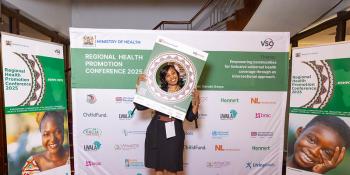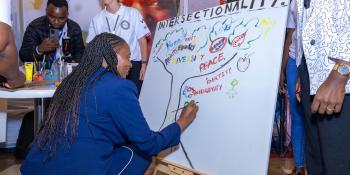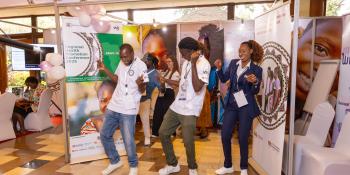In Cambodia, rice farmers are struggling with growing costs and stagnant markets. They are taking out loans to cope in the difficult months and when they cannot repay them they're forced to migrate towards cities or overseas in search of work, leaving behind children and aged parents to care for the rice fields.
Last year, the price went through the floor. We are still seeing the shock waves from that - in 2017 many farmers could not pay their loans.Dr MartinAgricultural adviser
“Last year we had what we call the rice crisis. Various things broke down."
Dr. Robert Martin has seen this first hand. In his role as agricultural adviser at the Australian Centre for International Agricultural Research in Cambodia, a VSO partner, Dr Martin has been watching the economic and social fabric of rice-growing in the country disintegrate, as thousands upon thousands of increasingly desperate farmers down tools and abandon their fields. In 2016, things were particularly bad.
Farmers have been forced to sell their rice at low market prices, taking out loans to help them cope. The repayments come with high rates of interest, keeping them in a cycle of debt. Often, the only viable option is to find paid employment overseas. Some farmer also have to sell the family land to pay back the loan.
“Farmers are getting squeezed”
Dr Martin is one of the advisers to VSO's Improving Market Access for the Poor (IMA4P) project. He's been supporting farmers dependent on rice farming, who've begun to really struggle in recent years. Global market forces have increased the costs of pesticides and labour significantly, while the price at which rice is bought is in decline.
These economic trends are squeezing farmers used to growing and selling rice. As a result, many are being forced to give up and leave their lands in search of better opportunities.
For young Cambodians like Mongkol Lyn, 26, the problem affects far more than the economy; it is the future of his country. He is passionate about changing things and is taking action by volunteering.
Mongkol has been training farmers as a facilitator of VSO's project in Battambang, where most families are dependent on agriculture to survive.
“I saw how farmers sadly had to sell off their paddy for a really low price. Sometimes, they had a huge loan with a high interest rate and had to sell back the land at a loss when they couldn’t get a profit from their rice. They might then have to emigrate to Thailand, Korea or Malaysia to find work.”
When farmers migrate, their fields are left in the care of relatives, or sold to pay off debts.
“Looking at some of the rice fields around, they did not come back,” adds Dr Martin.
Leaving rice fields behind
As a result of the migration of farmers, the numbers of farmers available to work the farms is quickly declining.
“We don’t have much manpower,” says Bunika San. As an agricultural expert he is working on new technologies that make it possible for aged grandparents to easily and efficiently tend to farms.
“As people leave to work in factories in Japan, Malaysia and Korea, we lose millions of Cambodian farmers.”
According to VSO research, conducted in 2016, unless a farm is at least five hectares large, it is nearly impossible to make it profitable from growing rice alone.
“The problem is that the average rice farm in Battambang is almost three hectares. They have to diversify, either with vegetables, livestock or with a small business,” says Dr Martin.
Larger farms can use machinery and technology to keep their farms going, but for the smaller farms of poorer families, this is not an option.
Exploitation
The exodus has created challenges not just for the economy, but for the social fabric of Cambodia.
Migrant labourers travel to countries as far flung as Japan, Malaysia, and Korea. But the majority travel to neighbouring Thailand.
Many estimates suggest close to 200,000 Cambodian workers in Thailand alone, have migrated illegally.
Once in Thailand, work tends to be menial and low-paid, often taking place in factories for long hours.
Many of these immigrants are undocumented. Reports of migrant Cambodian workers, enslaved in horrific conditions processing seafood for overseas markets, demonstrate just how vulnerable these people are to abuse and exploitation.
It speaks volumes about the lengths workers will go to be able to send money home to their families. But, as VSO volunteer Giovanni Villafuerte puts it, it is still “far more profitable for them to earn an income in Thailand and send money home”.
Giovanni gives an example of a young family where the parents were forced to migrate to Thailand, leaving behind young children to be cared for by grandparents. Every month, they send home money to ensure the children can eat comfortably and have enough money to go to school.
Farmers work with other farmers to be more efficient, getting access to good markets, a better price, with a higher yield - together.Mongkol LynA young volunteer
It is a sad reality that for many parents, the only way to provide for their children is to migrate away from their farms to places of work. Leaving the children with their grandparents. These households are labelled 'gap households.'
“This is a big issue. We have households that we call gap households, left with the grandparents, and the children or the grandchildren. So the capacity of the household to operate the farm at full capacity is very limited.” says Robert Martin.
It's hardly surprising that leaving the fields in the hands of the elderly, or the very young and inexperienced, leads to poor yields, and more failed harvests. It's keeping Cambodia's farming families trapped in a cycle of poverty.
Power in numbers
But things are changing.
Slowly, farmers are building their own safety nets – through each other and their networks. It means for the first time, farmers are willing to take business risks, safe in the knowledge that there is a market to buy their crop.
“Farmers here just think of farming as a traditional thing that their parents and grandparents have done. We’re injecting business concepts, like calculating input costs, labour costs, and pesticides. It will help them make better decisions.” Says volunteer Giovanni.
With support, farmers are using the power of the collective to buy goods like fertiliser at a lower cost and pooling their profits to support members to set up their own social enterprises.
The ripple effects of that are huge. For the first time, farmers are representing themselves. Lucy Kozmova, VSO's IMA4P global project manager says, “We’re starting to see farmers getting into policy and advocacy issues. You don’t often see that in a livelihoods project.”
Mongkol Lyn, the young Cambodian volunteer, is still optimistic about his country's future:
“Farmers work with other farmers to be more efficient, getting access to good markets, a better price, with a higher yield - together.”
Hope for the future
As they navigate a shifting global market, and a changing environment, farmers are coming to realise that their best bet is each other. Together, they are building reasons to stay in rural areas.
As a collective they are able to negotiate better prices for bank loans and spread the costs of fertilisers and seeds – things that would have been impossible alone. By selling their crops together, they are able to bargain for higher prices, making it possible to be profitable - even for smaller farms.
These changes could affect far more than just the rice production in Cambodia. The hope is that it will give farmers a reason to stay in their fields, stable incomes and family units that are not torn apart by migration.
Together, they are fighting the systems that have been pushing them to leave by pushing back. In ways big and small, farmers themselves are recognising the need for things to change and coming together to change them.
Read more

In photos: Our Regional Health Promotion Conference 2025
Check out some of our favourite photos from Regional Health Promotion Conference (RHPC25). This event sought to reimagine Universal Health Coverage through the lens of intersectionality.

Using intersectionality to create healthy beginnings and hopeful futures
World Health Day brings global attention to the urgent need to end preventable maternal and newborn deaths. Learn more about how our Regional Health Promotion Conference is tackling these issues head on.

Highlights from the Regional Health Promotion Conference 2025
The Regional Health Promotion Conference 2025 reimagined Universal Health Coverage (UHC) through the lens of intersectionality, by bringing together experts from across East Africa and beyond.
